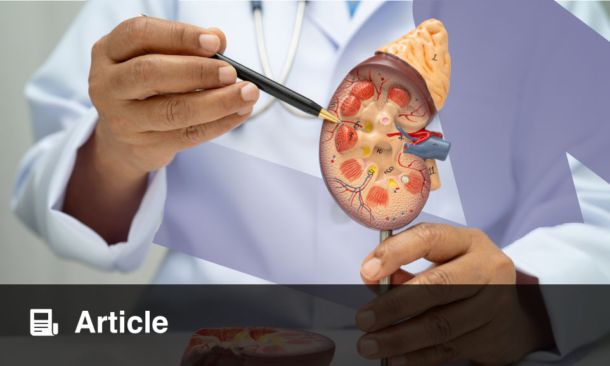Written by Evan Kimber | Editorial Assistant, EMJ
![]()
THE ‘INNOVATIONS in Haemodialysis’ session of this year’s European Renal Association –European Dialysis and Transplant Association (ERA-EDTA) Virtual Congress 2021 focused on discussing important inclusions to the design and development of new haemodialysis (HD) therapies. Presentations elaborated upon the expected direction for portable dialysis machines, the progressions in expanded HD (HDx) using new membranes, and strategies to reduce organ ischaemia with modern technology.
Karin Gerritsen from the Utrecht University Medical Centre, the Netherlands, opened the session by contextualising the transition of dialysis machines and their expected course of progression. Marie Evans from the Karolinska Institutet, Solna, Sweden, complimented these insights by describing new advancements in HDx, and Christopher McIntyre from the University of Western Ontario, Canada, described some of the modern initiatives that aim to reduce the existing issues associated with HD.
THE JOURNEY TOWARDS PORTABLE DIALYSIS
A commonly emerging theme in this session was the slow rate of advancement in the concepts and practice of HD since its conception; Gerritsen begun by recognising Willem Kolff as the father of HD and described the bulky, impractical devices in use today as not too dissimilar to those of his invention. Currently, there are several compact HD machines on the market that use low dialysate volumes for short, daily dialysis, but Gerritsen emphasised a key goal in modern nephrology is to provide an implantable kidney. Describing the latest developments in the field, she outlined several portable devices under development that do not require a fixed water supply.
Current challenges in miniaturisation include difficulty removing urea from dialysate, achieving high clearance with a low dialysate volume or flow, plus ensuring toxic uraemic clearance. However, Gerritsen highlighted that strategies involving electro-oxidation and biohybrid systems are under investigation to combat these problems.
NEW DEVICES AND THEIR FUTURE EXPECTATIONS
Developing an implanted kidney is a concept of the future, considering that most devices today are single-pass HD machines and weigh 20–35 kg. Gerritsen mentioned how emerging miniature dialysis devices are showing promise through employing regeneration of dialysate, ahead of a water supply. For example, NextKidney and Wearable Artificial Kidney devices incorporate a purification unit, which creates a closed loop, improving the practicality of a wearable machine. These continuous-flow peritoneal dialysis devices use recirculation dialysis technology once per day to effectively remove urea and maintain more stable glucose concentrations; they are expected to become available soon and future innovations could facilitate the steps in miniaturisation to wearable dimensions.
EVIDENCE OF IMPROVEMENTS WITH NEW MEMBRANES?
Evans gave insight on middle molecule (MM) accumulation associated with dialysis-related issues, such as anaemia. Difficulty lies with clearing molecules larger than 50 kDA; with standard diffusive transport in dialysis, convective clearance remains dependent on ultrafiltration rate and sieving coefficient. Evans highlighted that there is greater clearance of MM with large convective volumes during haemodiafiltration (HDF) and referenced two large randomised controlled trials comparing high-flux HD with HDF.
She then discussed several long-term studies investigating medium cut-off membrane (MCO) dialysis; compelling evidence describes safe and effective treatment whereby increased pore size is shown to improve clearance rate. Consequently, MCO dialysers improved quality of life, specifically by reducing the symptoms of pruritis, restless legs, and recovery time. It should be noted, however, that this technique poses a risk in exposure to endotoxins and is limited by its failure to improve clinical outcomes such as mortality, hospitalisation rates, and cardiovascular events.
HAEMODIALYSIS THERAPY TODAY
According to Evans, HDx could offer a cost-effective alternative in patients without access to HDF who do not achieve substitution volumes of 23 L, based on improvements in MM clearance outlined at normal blood flows. Demand for water, a limited resource, is also less than in HDF, making HDx a more environmentally friendly option for symptomatic improvement. Evans highlighted the possibility that MCO membranes might be able to offer treatment at home with standard dialysis fluid in the near future.
ORGAN ISCHAEMIA DURING HAEMODIALYSIS
Last in proceedings, McIntyre begun by referencing a similar talk he delivered at ERA–EDTA 2004 and emphasised that he felt there has been little change since then. He raised a two-fold problem concerning the specialists and industrial partners involved in HD: not caring enough about the topic; embedded in a conservative, poorly funded, and un-innovative market in dire need of refreshment.
McIntyre expanded on a need for change, highlighting the strong existing evidence that current HD practice results in multiple, segmental ischaemic insults that are cumulative and result in fixed injury. This is particularly detrimental in cardiac tissue and the brain, where cytotoxic oedema appears during dialysis and is harmful to white matter, reducing cognitive performance.
CAN MODERN TECHNOLOGIES HELP?
McIntyre outlined the opportunities for biohacking, involving permanent implants that offer a sensitive vasomotor control for dialysis, alongside monitoring devices to personalise treatment based on markers such as ultrafiltration rate and cardiovascular stress. He described the dangers of sodium storage, a crucial uraemic toxin: microscopy has demonstrated impaired function of the endothelial proteoglycan layer, which facilitates sodium transport, and accumulating high levels is associated with reduced survival in patients receiving renal replacement therapy.
Moving on, McIntyre briefly described the studies underway analysing peritoneum implants, subcutaneous pumps, and bladder catheters as examples of research aimed at improving dialysers through the use of emerging magnet initiatives. He finished by running through a mathematically modelled simulation of myocardial perfusion with electrophysiological activity as an example of the individualised dialysis under development, and stressed the importance of funding research partners.
FUTURE DIRECTIONS
Reflecting on the barriers to progression in his concluding remarks, McIntyre commented: “I’m not hopeful for the next 2-3 years, but beyond that these solutions could work for various stakeholders.” He went on to suggest that “society has a reason to take note of dialysis: they don’t currently realise how much they are paying for it.”






